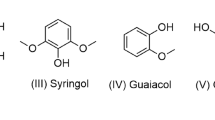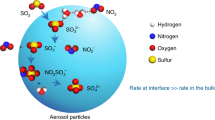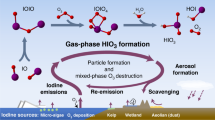Abstract
Short path gas cell Fourier transform infrared spectroscopy was used to analyze the production of hydrochloric acid (HCl) gas from the reaction of sodium chloride (NaCl) particles and sulfuric acid (H2SO4) or nitric acid (HNO3) at a range of relative humidity (2–95 %). HCl was produced from both acids, and reached equilibrium in 10 min for both H2SO4 and HNO3 acids. The equilibrium is thought to be a result of two competing reactions which produce HCl and sequester it back into the NaCl particles. The HCl production from H2SO4 was instantaneous, but its production from HNO3 involved an induction period of a few minutes. The equilibrium HCl conditions observed here have implications in influencing the pH of aerosol particles, and consequently the acidity of precipitation in the atmosphere.







Similar content being viewed by others
References
Graedel TE, Keene WC (1995) Tropospheric budget of reactive chlorine. Glob Biogeochem Cycles 9:47–77. doi:10.1029/94GB03103
McCulloch A, Aucott ML, Benkovitz CM et al (1999) Global emissions of hydrogen chloride and chloromethane from coal combustion, incineration, and industrial activities: reactive Chlorine Emissions Inventory. J Geophys Res 104:8391–8403
Erickson DJ, Seuzaret C, Keene WC, Gong SL (1999) A general circulation model based calculation of HCl and ClNO2 production from sea salt dechlorination: reactive Chlorine Emissions Inventory. J Geophys Res 104:8347. doi:10.1029/98JD01384
Sanhueza E (2001) Hydrochloric acid from chlorocarbons: a significant global source of background rain acidity. Tellus B 53:122–132. doi:10.1034/j.1600-0889.2001.d01-11.x
Finlayson-Pitts BJ, Pitts JNJ (2000) Chemistry of the upper and lower atmosphere: theory, experiments, and applications, 1st edn. Academic Press, San Diego
Eldering A, Solomon PA, Salmon LG et al (1991) Hydrochloric acid: a regional perspective on concentrations and formation in the atmosphere of Southern California. Atmos Environ Part A 25:2091–2102. doi:10.1016/0960-1686(91)90086-M
Tang IN, Tridico AC, Fung KH (1997) Thermodynamic and optical properties of sea salt aerosols. J Geophys Res 102:23269–23275. doi:10.1029/97JD01806
Henriksson M, Warnqvist B (1979) Kinetics of the formation of HCl(g) by the reaction between NaCl(s) and SO2, O2, and H2O(g). Ind Eng Chem Process Des Dev 18:249–254
De Haan DO, Finlayson-Pitts BJ (1997) Knudsen cell studies of the reaction of gaseous nitric acid with synthetic sea salt at 298 K. J Phys Chem A 101:9993–9999. doi:10.1021/jp972450s
Ali HM, Iedema M, Yu X-Y, Cowin JP (2014) Ionic strength dependence of the oxidation of SO2 by H2O2 in sodium chloride particles. Atmos Environ 89:731–738. doi:10.1016/j.atmosenv.2014.02.045
Seinfeld JH, Pandis SN (1998) Atmospheric chemistry and physics: from air pollution to climate change, 1st edn. Wiley, New York
Herzberg G (1965) Spectra of diatomic molecules. D. Van Nostrand, Princeton, NJ
Ross SD (1999) Inorganic infrared and Raman spectra. McGraw-Hill, London
Sander R (1999) Compilation of Henry’ s law constants for inorganic and organic species of potential importance in environmental chemistry. Environ Chem 29:85–107
Pio CA, Harrison RM (1987) The equilibrium of ammonium chloride aerosol with gaseous hydrochloric acid and ammonia under tropospheric conditions. Atmos Environ 21:1243–1246. doi:10.1016/0004-6981(87)90253-8
Zangmeister CD, Pemberton JE (2000) Raman spectroscopy and atomic force microscopy of the reaction of sulfuric acid with sodium chloride. J Am Chem Soc 122:12289–12296
Nakamoto K (1986) Infrared and Raman spectra of inorganic and coordination compounds, 4th edn. Wiley, New York
Barraclough PB, Hall PG (1974) The adsorption of water vapour by lithium fluoride, sodium fluoride and sodium chloride. Surf Sci 46:393–417. doi:10.1016/0039-6028(74)90316-1
Wassermann B, Mirbt S, Reif J et al (1993) Clustered water adsorption on the NaCl(100) surface. J Chem Phys 98:10049. doi:10.1063/1.464438
Dai DJ, Peters SJ, Ewing GE (1995) Water adsorption and dissociation on NaCl surfaces. J Phys Chem 99:10299–10304. doi:10.1021/j100025a035
Benson SW, Richardson RL (1955) The catalytic effect of water upon the addition of hydrogen chloride gas to solid sodium sulfate 1. J Am Chem Soc 77:4206–4208. doi:10.1021/ja01621a006
Beichert P, Finlayson-pitts BJ (1996) Knudsen cell studies of the uptake of gaseous HNO3 and other oxides of nitrogen on solid nacl: the role of surface-adsorbed water. J Phys Chem 100:15218–15228
Ten Brink HM (1998) Reactive uptake of HNO3 and H2SO4 in sea-salt (NaCl) particles. J Aerosol Sci 29:57–64. doi:10.1016/S0021-8502(97)00460-6
Acknowledgments
Funding was provided by Arkansas Science Technology Authority (ASTA) summer internship program and Arkansas State University (ASU) faculty research awards. We would also like to acknowledge Dr. Ben Rougeau for his continued support with instrument calibrations.
Author information
Authors and Affiliations
Corresponding author
Rights and permissions
About this article
Cite this article
Fong, B.N., Newhouse, K.V. & Ali, H. Effect of relative humidity on HCl formation from the reaction of H2SO4 and HNO3 with NaCl particles. Reac Kinet Mech Cat 116, 273–283 (2015). https://doi.org/10.1007/s11144-015-0890-8
Received:
Accepted:
Published:
Issue Date:
DOI: https://doi.org/10.1007/s11144-015-0890-8




